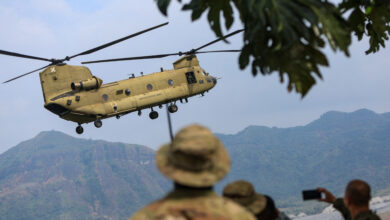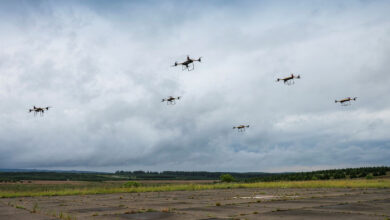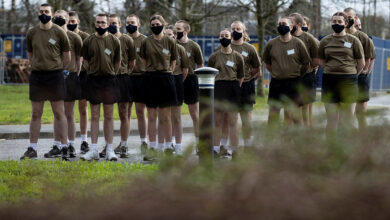Coalition drives to build Iraqi Kurdistan’s Peshmerga into a self-sustaining force
Personnel from 7 European Coalition nations will soon transition from direct training to mentoring the Kurdistan region’s iconic Peshmerga force
ERBIL, Kurdistan Region of Iraq – At the Bnaslawa training center outside Erbil in the Kurdistan Region of Iraq, 12 Yazidi women from Sinjar, the youngest 19 years old, are training to be combat medics for the Peshmerga – literally, “those who face death” – the military force in the autonomous region that was critical in the war against Islamic State.
Two gender advisors from the U.S.-led Coalition against ISIS were present when The Defense Post visited Peshmerga training centers in Sulaymaniyah and Erbil last week alongside personnel from the Italian Army, who currently lead the multi-national Kurdistan Training Coordination Center.
Formed in 2015 and based in Erbil, the capital of Iraqi Kurdistan, the KTCC officially became part of Combined Joint Task Force – Operation Inherent Resolve last year. In addition to Italy, Finland, Germany, Hungary, the Netherlands, Slovenia, and the United Kingdom contribute to the KTCC.
Almost 50,000 Peshmerga have been trained by the KTCC so far, around 12,000 per year. Next summer they hope to move to a mentorship relationship instead of direct training, and the rush is on to prepare Peshmerga to take charge of their own security.
The female Peshmerga all agreed to be photographed and identified by their first names for this story. The Defense Post agreed to obscure the faces of KTCC personnel except for the commander, Italian Army Colonel Giuseppe Levato. The gender advisors, Australian Army Lieutenant Colonel Kathryn (Kate) Henderson and Superintendent Marie-Claude Côté from the Royal Canadian Mounted Police, agreed to be named and have their faces photographed.

“This is a very important course. Medic is one of the most important qualifying courses,” Levato told the assembled group. The Yazidi women training in Bnaslawa all joined in 2015 during the height of the war against ISIS in Iraq. The youngest is now 19 years old. They had just 43 days of military training back then, and three hours of medical training before this course.
One of the women in the medic course – Aziza, from Sinjar – came to Iraqi Kurdistan after ISIS attacked her hometown, enslaved many of the Yazidi women, and massacred most of the men. Now as a Zerevani – a specialized Peshmerga unit that falls under the Kurdistan Regional Government Ministry of Interior – she does the same jobs as her male counterparts, mostly running checkpoints, although men and women still work in separate places.
Some 1,500 Peshmerga died in the war against ISIS and at least 10,000 more were wounded.
The KTCC’s seven-week courses are Wide Area Security infantry tactics, combat medicine, marksmanship, counter-IED measures, field tactics, and Chemical, Biological, Radiological and Nuclear protective measures, the latter deemed important due to the lingering memory of Saddam Hussein’s genocidal mustard gas and nerve agent attack on the Kurdish city of Halabja that killed thousands in 1988. Levato, who is due to rotate out soon, introduced a mechanised infantry component to the program.
There are four women in the instructor course in Bnaslawa and the KTCC is running its second female medic course under the leadership of a male Finnish Army Sergeant First Class with 21 years of service. A female Finnish Army doctor was teaching the medics when The Defense Post visited.
Eventually these women will be able to not only provide battlefield care, but train other women and men.
In the first two weeks of the course the women discussed cultural and religious differences important to the region, and what they felt comfortable doing. During the visit they asked the men – except the course leader – to leave the room as they demonstrated a casualty triage.
“We improvise a lot,” said the female Finnish Army doctor, especially with regard to how much skin the women are willing to expose when learning how to use a chest seal, or choosing how much to take part when practicing on each other – and they have to balance it all without cutting corners.

The Peshmerga students decide on a scenario: one casualty or two casualties? Is it a leg amputation? A young woman called Mareen volunteers to be the patient.
“She stepped on a mine – and what other symptoms does she have?” the instructor asks.
“You can feel her skin is really cold … now she starts to vomit.”
One of the two students working on Mareen turns the victim and mimes wiping bile from her exposed teeth and the inside of her mouth. As a last step, they wrap her body in a shock blanket and step back. Mareen will survive.
For the rest of the course the women will learn infantry basics and then move on to tactical medical training in the field, making the whole thing more real.
Across the road, a Russian instructor with the United Nations is leading a course for officers on the law of armed conflict and sexual and gender-based violence. The uniformed men blanch when they’re told to break into groups and imagine themselves to be girls for five minutes to better understand gender power dynamics.

Downrange, another female Zerevani from Sinjar is two weeks away from finishing her instructor training. To the sound of gunfire, she explains how she’s learning to train 35 men how to attack, retreat and conduct a patrol on the battlefield.
“In the beginning it was a bit difficult,” she said. “Everything in the beginning is a bit new and it’s difficult.”
Peshmerga reform
Eventually the goal is to get a unified Peshmerga, and to fold the entire force into the regular Iraqi Security Forces, under control of the federal government and trained by the Coalition in Baghdad.
But that’s years away, Levato said, and outside the Coalition’s hands. Although many are veterans of the war against ISIS, Peshmerga students in the KTCC courses could also be farmers or teachers who live hours away and most of their training has been from the ground up.

Political divisions within the Kurdistan Region further complicate things: the factious two main parties, the Patriotic Union of Kurdistan (PUK) and Kurdistan Democratic Party (KDP) both command their own Peshmerga forces, as well as affiliated militias, Unit 70 (PUK) and Unit 80 (KDP), who are not under the direct command of the Ministry of Peshmerga or the Interior Ministry, and are not trained by the Coalition.
There are 14 Peshmerga brigades roughly evenly divided between the KDP in Dohuk and Erbil in the north of the region and the PUK in Sulaymaniyah, in the south.
When The Defense Post visited the Sulaymaniyah base – a comfortable 45-minute ride from Erbil by Italian Army NH90 helicopter – Peshmerga were training in the same tactics as their counterparts in Bnaslawa.
Among them was Zahra, who joined the Peshmerga in 2015 when she was a student and was now in the marksman course.
“I had a lot of family in Mosul, and one of my female relatives was captured by ISIS, so I decided to do something to protect myself,” she said.
Peshmerga who complete the level-3 course will be qualified to train other personnel; those who pass the T5 Master Instructor course will be training the trainers. Already some level-3 trainers are taking advanced courses to become level-5 trainers, and the KTCC has designed new badges, blue and red, for each of their areas of expertise.
Right now there are more than 400 people training in Sulaymaniyah, including eight in the master instructor course, according to the base commander, General Amad Muhammad Hamad.
So far in the entire Kurdistan region more than 300 instructors have been trained; the master program is in its third course. “So it’s only the beginning,” Levato said. Out of a group of 25, two or three will qualify as masters, he said. This is all part of the plan to make the Peshmerga self-sustainable.
Professionalizing the Peshmerga
There are problems that come with trying to stand up a non-professional military and turn farmers into soldiers.
Training the Yazidi women has been slow, the medical course leader said. Some of them are just now reading at a third grade level. There are just two interpreters, including one Muslim woman who lives hours away from Bnaslawa. Nonetheless, the course leader is hoping to prepare some of them to be trainers.

In Bnaslawa, base commander Brigadier General Dier Habib Aptar is told about problems with payments – some of the female instructors aren’t receiving the allowance they’re entitled to when traveling back and forth to the training centers. It’s a common issue: money doesn’t always make it down the pipeline from Baghdad, and instructors are only paid for part of the seven-week course. People have gone on strike due to the money just not coming through.
The incoming commander, Colonel Stefano Panoni, will be the first to oversee the KTCC’s mentorship of the Peshmerga. When the program began in 2014, Coalition forces were in charge of 100% of the training. During the next rotation the Peshmerga will be training themselves.
“Now they are able to perform basic infantry actions, but to organize a battlefield and action at the battalion level, they need another kind of organization,” Panoni said.
Nepotism issues are also common in a place where many people are named Barzani and Talabani. There are gaps in the ranks, discipline is enforced varyingly from battalion to battalion, and it’s been very difficult to standardize, said KTCC Command Sergeant Major Marcel Koster, who is from the Royal Netherlands Army.
There is also no regular set training schedule. After their training, for “the rest of their duty, the rest of the year, they’re back home,” Koster said.
But the KTCC and the Peshmerga base commanders are hopeful.

And Levato, who has more than 35 years in the armed forces and previous experience with multinational missions at NATO headquarters and in Afghanistan, is clearly proud of the work the KTCC has done preparing the Peshmerga since he took command in June.
The Kurdistan region is largely safe, and American eyes are focused on Baghdad, where weeks of deadly protests have rocked the fragile federal government. But there is a risk of taking the security for granted; on November 10, five Italian special forces personnel were wounded by a roadside bomb while working with Iraqi troops in the area disputed between the KRG and Baghdad. The Peshmerga have to be prepared for whatever ISIS throws their way in the future.
“The Peshmerga forces have been through so many challenges,” said Aptar, who is the fourth Bnaslawa base commander and has served in the role since early 2015. After Saddam Hussein’s regime was overthrown in 2003, the Peshmerga entered a new phase as it moved towards becoming a proper military force.
And since the Coalition took over training in 2014 and instilled doctrine and higher-level leadership training, “we see a lot of progress here,” he said.
Jared Szuba contributed reporting from Sulaymaniyah.











